-
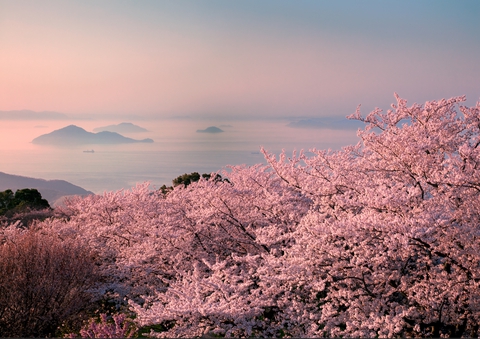
1Mt. Shiude
The Shonai Peninsula, at the northwestern tip of Kagawa Prefecture, offers remarkable views onto the island-dotted Seto Inland Sea. The best vistas can be enjoyed from the top of Mt. Shiude, a wooded peak where a scenic lookout provides views over both sides of the peninsula and across the sea toward Honshu, with Seto Ohashi Bridge in the distance. These views are particularly impressive in early spring, when the hundreds of sakura (cherry blossom) trees on the peninsula burst into bloom, painting the hillsides pink. In early summer, visitors can enjoy hydrangeas and azaleas blooming along the path to the lookout point.
Mt. Shiude has been a strategic vantage point since prehistoric times. Earthenware, weapons, and building foundations dating back to the Yayoi period (300 BCE–300 CE) have been excavated here. In later eras, sentries were able to monitor the busy Inland Sea shipping lanes, which remain major transport arteries today. The Mt. Shiude café, just beneath the lookout point, invites visitors to sit by its large east-facing windows, through which they can watch cargo ships passing in the distance using the binoculars provided.More Details
-
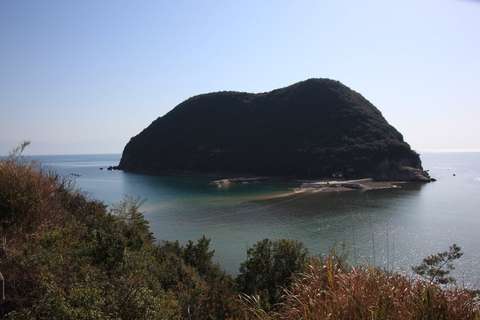
2Kamonokoshi and the Legend of Urashima Taro
Kamonokoshi, a tranquil, lagoon-like cove protected from the sea by a forested island, is said to be the birthplace of the Urashima Taro legend. One of Japan’s most beloved folk tales, it tells of a fisherman who stops a group of children teasing a turtle on a beach, thereby winning the creature’s gratitude. The turtle takes Taro to an underwater palace where the man meets a princess and is given a hero’s welcome. After several days at the palace, Taro asks to be taken home, but the princess only lets her guest go after giving him a mysterious box and telling him never to open it. Returning to his village, Taro finds that everything has changed; it is as if he has been gone for decades. He ignores the princess’s warning, opens the box, and immediately turns into a white-haired old man.
According to local tradition, it was the beach at Kamonokoshi where Taro saved the turtle. Urashima Shrine, on the other side of the cove, enshrines Taro himself, while a rather worn-down statue of the kind-hearted fisherman stands near the shrine’s torii gate. Visitors can walk to the shrine at low tide, when a sliver of white beach emerges from the emerald green waves. Take care to return before the tide rises again and the path disappears. After making it back to solid ground, consider staying until dusk, when the rock formations on the opposite side of the cove create a dramatic scene against the backdrop of the setting sun.More Details
-

3Chichibugahama Beach
Located in Mitoyo on the western coast of Kagawa Prefecture, Chichibugahama Beach has become extremely popular in recent years—especially among amateur photographers. The shallow beach, which is 1 kilometer long and up to 400 meters wide, looks particularly picturesque at low tide. When the sea recedes, water lingers in depressions and uneven spots on the beach, forming shallow pools. Pictured at a low angle, these pools function as natural mirrors when the water is calm, which it often is in the evening due to the shelter afforded by the nearby mountains. The best time for photos is at dusk during low tide, when the sun’s fiery rays from the horizon of the island-dotted Seto Inland Sea offer a spectacular backdrop to the myriad reflecting pools. After snapping away or watching fellow beach-goers pose by the pools, sightseers can grab a bite at one of the several cafés and restaurants that have sprung up at Chichibugahama, which now attracts more than 200,000 visitors per year. The beach is also a worthy destination for swimmers and sunbathers, who can look forward to smooth, virtually trash-free sands thanks to the efforts of local residents, who clean Chichibugahama daily throughout the year.
More Details
-
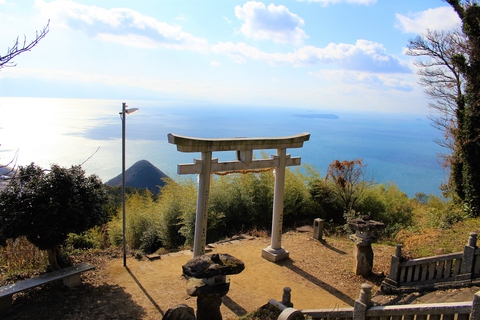
4Takaya Shrine
Takaya Shrine stands on the peak of the 404-meter Mt. Inazumi, from where it overlooks the coastal city of Kanonji. This Shinto shrine has more than a thousand years of history; it is mentioned in the Engishiki, a compilation of regulations and procedures completed in 927 CE. The shrine’s current buildings, however, are of less interest than its bulky stone torii (shrine gate), which was erected in 2009 to replace an old wooden gate that once stood on the same spot. The torii occupies the most picturesque location on the mountain, functioning as a frame for the impressive view over Kanonji and the islands of the Seto Inland Sea in the distance. A recently constructed road has made Takaya Shrine accessible by car, but active visitors can choose to walk to the sanctuary instead. The climb from the shrine’s lower hall (gegu), located at the foot of the mountain, takes about an hour and ends with a steep 270-step stone approach leading up to the torii.
More Details
-
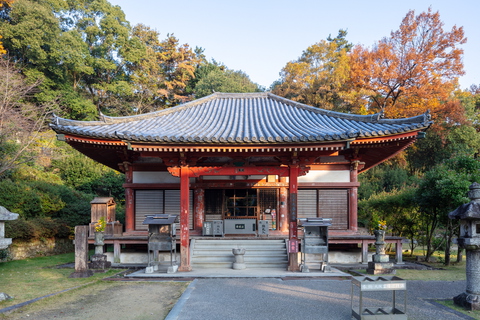
5Jinnein Temple and Kannonji Temple
Jinnein Temple and Kannonji Temple, the 68th and 69th temples on the Shikoku 88-Temple Pilgrimage circuit, are located just below the summit of Mt. Kotohiki in the city of Kan-onji in Kagawa Prefecture. What makes them unique is the fact that these are the only temples on the Pilgrimage circuit that are located on the same grounds. They even share the same chief priest.
Up until the Edo Period, which ended in 1868, the two temples were actually one and the same sanctuary. Historical documents from that period mention two places of worship on Mt. Kotohiki: Kotohiki Hachimangu Shrine, which was a Shinto shrine, and Kannonji Temple, which was a Buddhist temple associated with Kotohiki Hachimangu Shrine. At the time, Kotohiki Hachimangu Shrine was the 68th temple on the Shikoku 88-Temple Pilgrimage circuit, followed by Kannonji Temple.
While it may seem unusual for a Shinto shrine and a Buddhist temple to be associated, the fact is that, throughout history, the native Japanese Shinto religion and Buddhism, which was introduced to Japan in the 6th century, were always closely connected. That all changed with the arrival of a new government in the Meiji period after 1868. Japan suddenly opened up to the rest of the world after centuries of isolation, and the new government decided to draw a clear line between the two religions with the goal of unifying the nation spiritually for the new era.
This change in religious policy caused the Buddhist artifacts to be removed from Kotohiki Hachimangu Shrine and transferred to Saikondo Hall on the grounds of Kannonji Temple. Saikondo Hall then became known as the main hall of Jinnein Temple. At that time, Jinnein Temple also replaced Kotohiki Hachimangu Shrine as the 68th temple on the Shikoku 88-Temple Pilgrimage circuit. That is how the unique compound structure with both Jinnein Temple and Kannonji Temple located on the same grounds came to exist.
This particular site represents an essential part of Japanese cultural heritage, which is why the main hall of Kannonji Temple, known as Kondo Hall, has also been designated an Important Cultural Property.More Details
-

6Kotohiki Park
Kotohiki Park in the city of Kanonji is famous for the mysterious Zenigata Sand Coin, a seventeenth-century sand sculpture said to bring long life and luck in money matters to anyone who lays eyes upon it. The sizable sculpture can be viewed from the park’s elevated vista point, which also offers a panorama of the Seto Inland Sea. The sculpture is illuminated at night. Besides the Zenigata Sand Coin, the park is noted for its seaside environment, which is part of Setonaikai National Park, and for its historic sites, including several Buddhist temples and a Shinto shrine.
Seen from the vista point, directly beyond the Zenigata Sand Coin is Ariake Beach, a 2-kilometer strip of white sand. The shallow waters near the shore are a popular wading spot. Kotohiki Hachimangu Shrine stands on the summit of the forested Mt. Kotohiki nearby. A 381-step staircase leads up to the shrine from the main torii gate, located near the park entrance. Two Buddhist temples, Jinnein and Kannonji, which are the 68th and 69th temples on the Shikoku 88-Temple Pilgrimage, are located partway up the steps.More Details
-
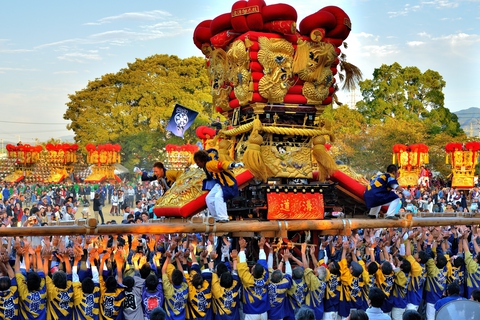
7Sanuki Toyohama Chosa Festival
Dazzling gold floats are paraded through the Toyohama neighborhood of Kanonji every autumn during the annual Sanuki Toyohama Chosa Festival. This celebration takes place over three days on the second weekend of October to express gratitude for a plentiful harvest and catch. It is named for its floats, or chosa, that are mounted with drums and carried through the streets of Toyohama. This type of float has traditionally been used in festivals throughout western Japan, but those in Toyohama and the surrounding area are some of the largest and most ornate anywhere. They are up to 5 meters tall, weigh 2 tons, and are carried on wooden poles 13 meters long. Their decorative features, including the massive stuffed-cord ribbon decorations called tonbo on the top, make the floats impressive sights when viewed up close.
Toyohama has a population of less than 10,000, but 22 of its 28 neighborhood associations have their own chosa. It takes about 70 well-coordinated carriers to maneuver a single float, which during the festival are carried to the sound of rhythmical chants. On the last day of the Chosa Festival, all 22 floats are carried to Ichinomiya Shrine, where each group puts on a performance that involves hoisting the float up and down and shaking it vigorously while drums are played and the participants shout in unison. Visitors who come to Toyohama outside of festival season can get a taste of the action at the Chosa Festival Exhibition Hall, where some of the floats are displayed and video of the festival plays on a big screen.More Details
